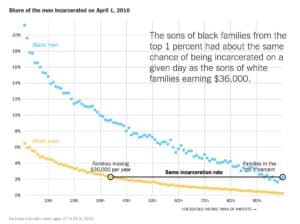Chetty: Affluent Black Males Much More Crime-Prone, Whites at Fault
Steve Sailer, Unz Review, March 19, 2018
New data from Stanford economist Raj Chetty. {snip}
From the New York Times’ Upshot section:
Extensive Data Shows Punishing Reach of Racism for Black Boys
{snip}
So much for the Theory of Intersectionality.
Actually, the “putative” IQ differences are handicapping black women relative to white women: a much higher percentage of white women grew up in, say, the overall top one percent of income than did black women, just as cognitive test scores would predict. What Chetty has found is instead that there is a disparity between current income of black women and black men of the same income background.
It’s almost as if America has had a giant system of affirmative action over the last half century to benefit blacks, but it doesn’t work for blacks who are criminals. So it benefits black women far more than it benefits black men because of, as Chetty’s data demonstrates, the black males’ extremely high rate of serious criminality. {snip}
As for black women vs. white women, keep in mind, it’s not there are no differences in income distribution between white and black women — there are — it’s just that the small number of black women who grew up in affluent families tend to do about as well as white women who grew up in affluent families.
In contrast, black males growing up in all income levels have an unfortunate tendency to be keeping it real than white males who grew up in families at the same income level.
{snip}
“The few neighborhoods that met this standard were in areas that showed less discrimination in surveys and tests of racial bias. They mostly had low poverty rates. And, intriguingly, these pockets — including parts of the Maryland suburbs of Washington, and corners of Queens and the Bronx”
I.e., Prince George County, Maryland and the middle-class West Indian parts of New York, such as Eric Holder’s old neighborhood of West Indians that kept young Eric carefully wrapped in a bourgeois bubble away from poisonous African-American culture.
“ — were the places where many lower-income black children had fathers at home. Poor black boys did well in such places, whether their own fathers were present or not.”
Because there aren’t street gangs to join and the other boys are scared their fathers would be mad if they started their own street gang.
The chief problem with being poor in 21st Century America is not that you can’t afford to buy enough stuff, it’s that you can’t afford to move away from other poor people.
{snip}
“Other studies show that boys, across races, are more sensitive than girls to disadvantages like growing up in poverty or facing discrimination.”
Another way to think about this is that female behavior is relatively similar across cultures while male behavior is what determines the type of culture.
{snip}
“It’s not just being black but being male that has been hyper-stereotyped in this negative way, in which we’ve made black men scary, intimidating, with a propensity toward violence,” said Noelle Hurd, a psychology professor at the University of Virginia….”
But of course we can tell from the racial distribution of NFL cornerbacks that it’s actually Asian Indians who are most sought out by pro teams for their ability to deal out instant violence to pass receivers.
{snip}
[Click the image to enlarge it.]
{snip
“As this chart shows, a black man raised by two parents together in the 90th percentile — making around $140,000 a year — earns about the same in adulthood as a white man raised by a single mother making $60,000 alone.”
Regression toward the mean.
















